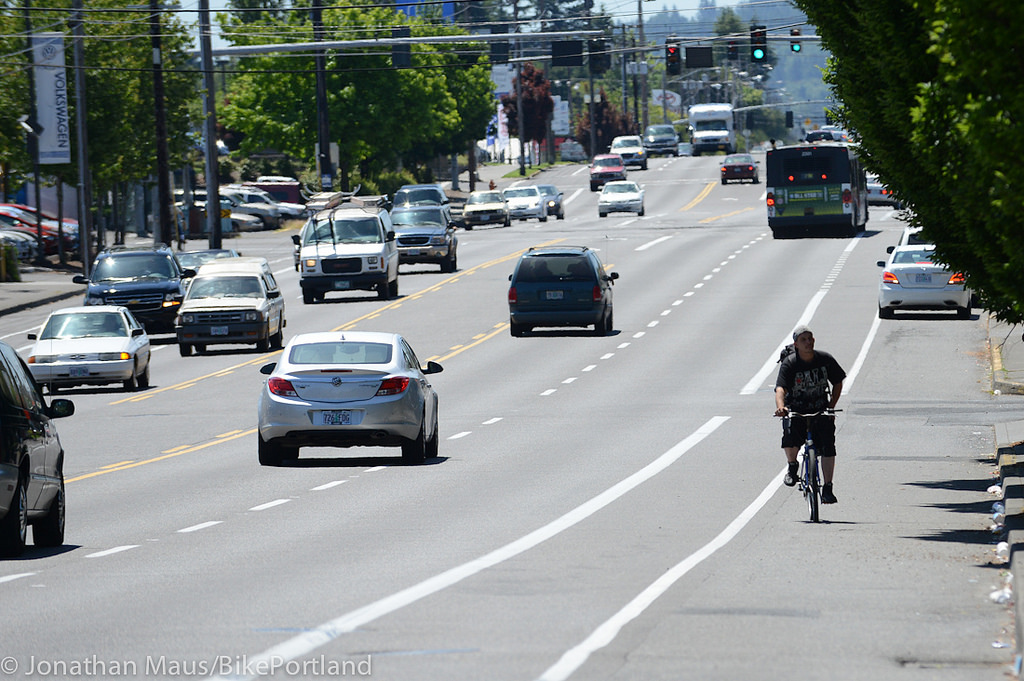
(Photo: Jonathan Maus)
“There’s a bit of almost a giddy feeling when you think about how many things are going to happen.”
— Kem Marks, The Rosewood Initiative
2018 could go down in history as an inflection point for east Portland. After years of activism and advocacy — and planning and politicking by local governments — a part of our city that has been historically neglected since it was annexed a half-century ago is slated for an infusion of transportation infrastructure investment the likes of which we’ve never seen before.
Tonight (5/16) at an event on SE 122nd Avenue, the Portland Bureau of Transportation kicks off the first of two open houses that will feature nearly two dozen projects and programs aimed at making east Portland streets safer and more convenient. Between projects slated to break ground this summer and next, there’s so much going on it’s hard to keep up.
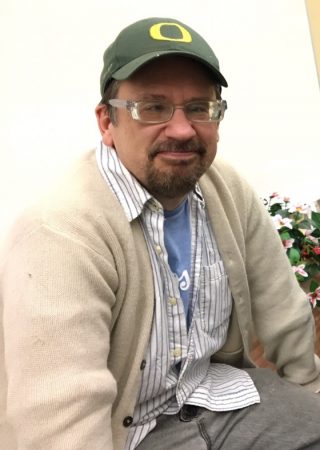
(Photo: Jonathan Maus)
Since the East Portland in Motion plan was adopted by Portland City Council in 2012, PBOT estimates they’ve delivered $255 million worth of projects (see PDF below). Between 2018 and 2019, the City’s Fixing our Streets Program alone will invest an estimated $22.4 million in 19 projects east of 82nd. Earlier this month, PBOT Bicycle Advisory Committee member Jim Chasse (a veteran east Portland activist) said the City was “very generous” when it agreed to a request by the East Portland Land Use and Transportation Committee to spend $15 million in Transportation System Development Charges on languishing active transportation projects (which have since been leveraged to $28 million).
“It’s a great thing to see, there’s a bit of almost a giddy feeling when you think about how many things are going to happen,” The Rosewood Initiative’s Director of Transportation Equity Kem Marks shared with me today in a phone interview. “I think the main feeling out here is — it’s about bloody time!”
Marks says this stream of projects is the direct result of blood, sweat and tears from advocates who worked the process for years to line them up. Planning efforts like East Portland in Motion and the East Portland Action Plan’s Bike Committee helped identify projects, make them a priority, and then push them onto appropriate lists. But perhaps more importantly, these efforts have helped organize, mobilize, and radicalize a slew of activists who have become some of the most effective at swaying City Hall — even from neighborhoods many miles away from it.
Here’s a look at just some of the projects and plans in the pipeline:
[pdf-embedder url=”https://bikeportland.org/wp-content/uploads/2018/05/E-Portland-funded-projects_Poster_5-16-18.pdf” title=”E Portland funded projects_Poster_5-16-18″]
Advertisement
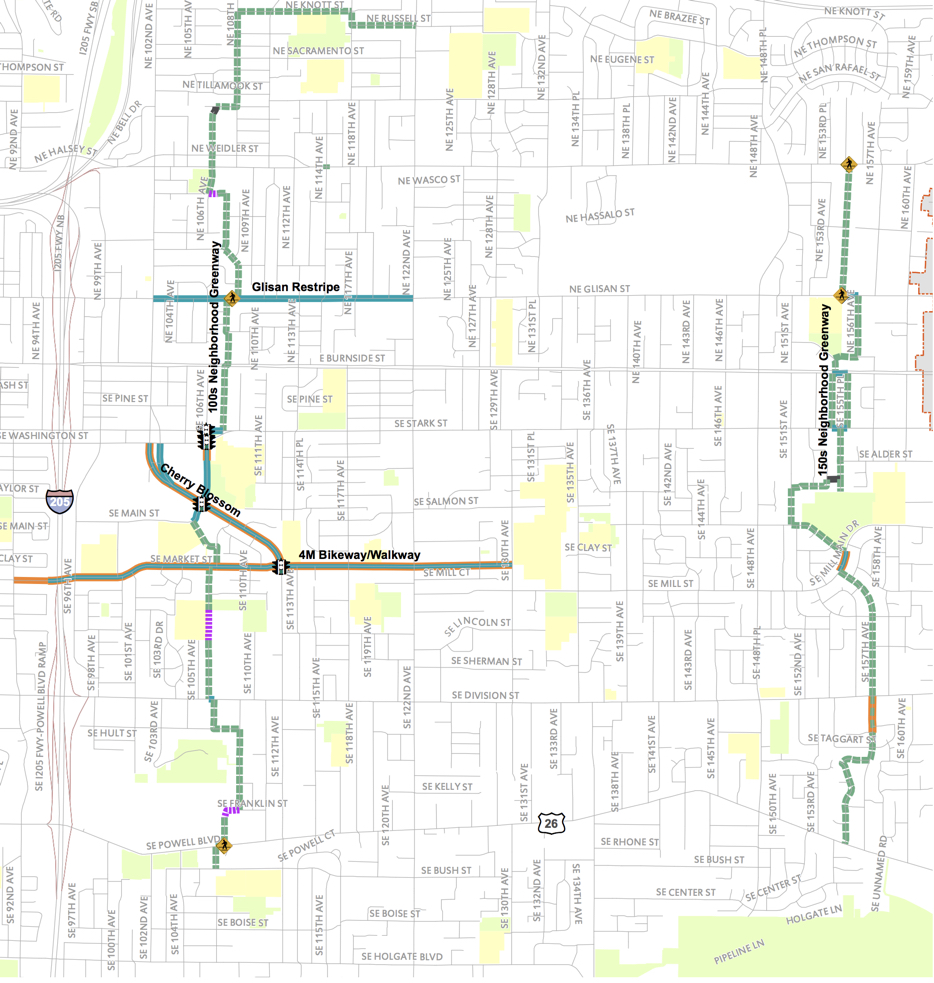
(PBOT)
–> PBOT has a slew of changes coming as part of their federally funded $6.5 million East Portland Access to Employment & Education (EPAEE) project (which seriously needs a better name). The project includes: the 4M Neighborhood Greenway which will run on SE Market, Mill and Millmain between SE 92nd Avenue and SE 130th Avenue; sidewalks on SE Cherry Blossom Drive between Market and Washington; two other neighborhood greenway projects that will run north-south on the 100s between SE Bush and NE Fargo and the 150s between SE Powell and NE Halsey. SE 106th will also get several improvements: a two-way cycle track between SE Main and Stark, and new sections of paved path to fill in gaps at NE Wasco, NE San Rafael and between Division and Market (near Cherry City Park). Construction is slated to begin in 2019.
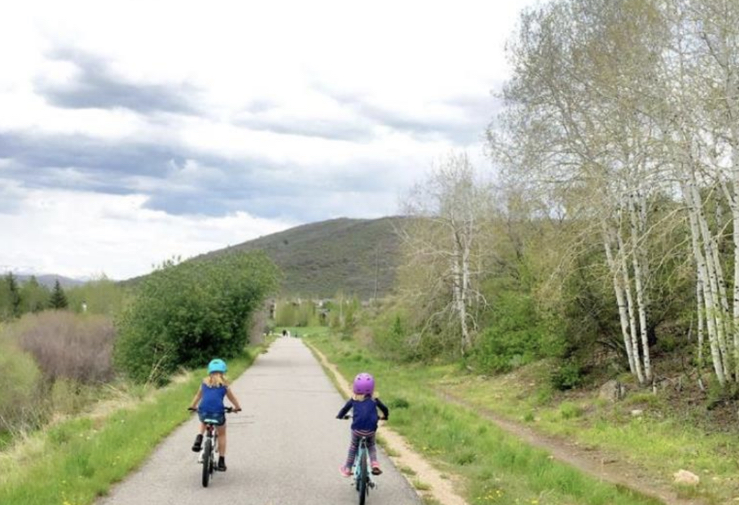
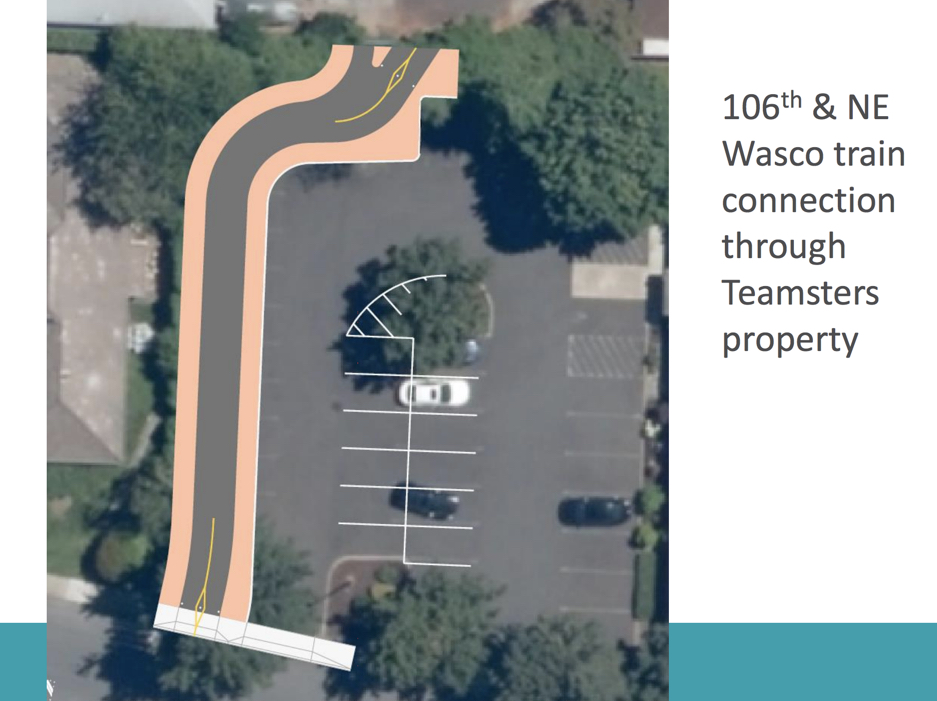
(PBOT)
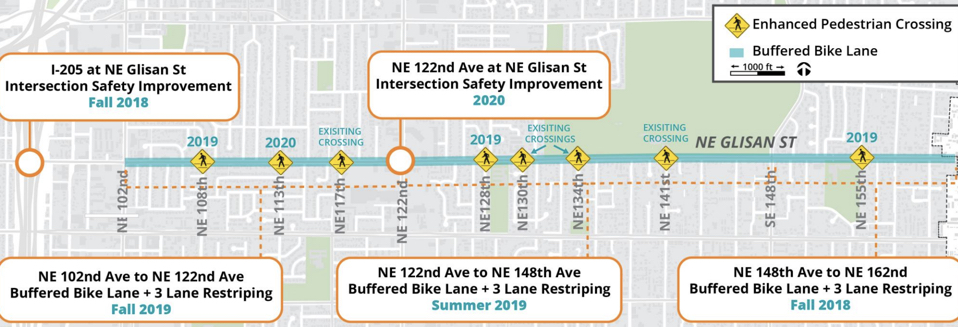
(PBOT)
–> The East Glisan Street Update project will reallocate space on Glisan between I-205 to NE 162nd (city limits). As one of the lynchpins in the emerging outer northeast bike network via the Gateway to Opportunity project, PBOT will redesign the current cross-section of Glisan. Instead of the classic, dangerous arterial design of four standard lanes, a center turn lane and on-street parking lanes on both sides; PBOT will restripe it with two standard lanes, a center turn lane and unprotected, paint-only buffered bike lanes.
Unfortunately, PBOT says physically protected bike lanes aren’t in the budget. At the May 8th Bicycle Advisory Committee meeting PBOT Project Manager Timur Ender said the agency is, “Actively searching for funding internally; but I don’t want to overpromise and underdeliver.”
–> PBOT just kicked off their 122nd Ave Plan, which aims to “improve pedestrian and bicycle access and support better transit” on the notoriously dangerous arterial between SE Foster Road and NE Marine Drive.
“I worry people are going to die if we’re encouraging people to bike where cars are going so fast.”
— Sarah Iannarone, Bicycle Advisory Committee member
For Marks and other people who care about safe streets in east Portland, the next challenge is to make sure these projects are substantive enough to move the needle. There’s a reason so many people are hurt and killed while using east Portland’s arterials: they’re wide and straight and they encourage fast, unsafe driving.
PBOT’s Timur Ender got a taste of that concern after he presented some of these projects at the Bicycle Advisory Committee meeting. Committee member Sarah Iannarone, who lives near SE 148th and Powell, bluntly pointed out that, “I worry people are going to die if we’re encouraging people to bike where cars are going so fast.” Iannarone said she’s an “intrepid cyclist” but has all but given up cycling near her home because it’s so unsafe. She wants PBOT to lower speeds on arterials with bike lanes to 20 mph.
And Kem Marks with The Rosewood Initiative says their work will now shift to making sure these projects are as “transformative” as possible. “We want these projects to really make a difference, not just be band-aid projects,” he says. Marks is “skeptical but optimistic” about PBOT’s efforts to tame east Portland arterials. He wants to see PBOT do something like Better Naito in his neighborhood. “Are they willing to go and do something like that in this part of town?”
Learn more about these and many other east Portland projects online and/or at one of the two upcoming open houses. There’s also a PBOT-led ride tonight at 6:00 pm to explore future neighborhood greenways.
— Jonathan Maus: (503) 706-8804, @jonathan_maus on Twitter and jonathan@bikeportland.org
Never miss a story. Sign-up for the daily BP Headlines email.
BikePortland needs your support.



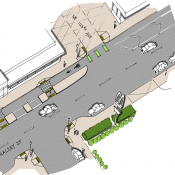
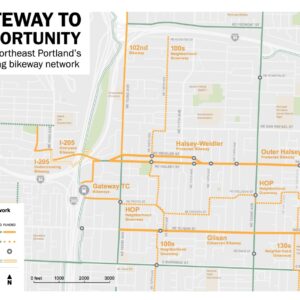
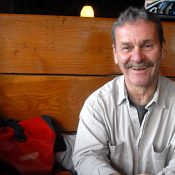
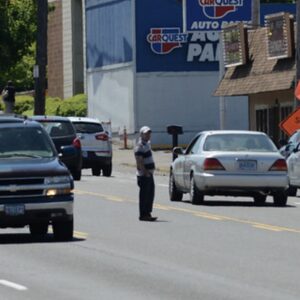
Thanks for reading.
BikePortland has served this community with independent community journalism since 2005. We rely on subscriptions from readers like you to survive. Your financial support is vital in keeping this valuable resource alive and well.
Please subscribe today to strengthen and expand our work.
Never lived east of 82nd (except in Saint Louis), but this is interesting.
Meanwhile, in Gresham, the city is planning on taking the existing 3-lane cross-section of NE Sandy Blvd between 181st and 201st and widening it to 5 lanes. They have not shared any of the concepts publicly, but I have seen advanced copies through my employer. I asked the engineers if the traffic counts justified the widening project, and they said that they didn’t have any data. The 5-lane configuration is “in the master plan”, so I guess they are just pushing ahead with it. I believe construction is slated to start in 2019.
Did Gresham face opposition?
I doubt it: “They have not shared any of the concepts publicly,”
I also hope the safety improvements are substantial. Working out on NE 132nd north of San Rafael, I occasionally have to ride 102 or 122 and that 6″ paint stripe does nothing for feeling safe, especially when you are also dodging the debris (rocks and glass) and drains. Then, the whole right turn lane is the bike lane is just plain a mess.
That walkway on the east side of the 102 Av. Bridge over I-84 is way too narrow and the wall is too low. Had to cross that regularly in the 1970s in high school and it always scared the heck out of me. It badly needs to be widened and modernized. Crosswalks on the I-205 Trail need safety upgrades and reduced speed limits. Most are next to busy freeway interchanges and motorists often are focusing on the on ramps and not the crosswalk. Better guide sugnage on the I-205 Trail and better connections to/from adjoining neighborhoods are a must.
Oof. If I had known about the one tonight I’d have liked to go to be a body to show support for all this. But getting off work at 5 and then riding home I’d be rolling in fairly late.
Just in case anyone was wondering about my evening schedule. Sorry for the dumbass comment.
Actually, I was wondering. Thanks for the update.
Thanks for the News. 😉
“…a part of our city that has been historically neglected since it was annexed a half-century ago is slated for an infusion of transportation infrastructure investment the likes of which we’ve never seen before.”
I’m wondering, where did this BS come from?
Half-century ago? Most of East Portland was annexed into the city between 1986 and 1991, so between 32 and 27 years ago; parts of Pleasant Valley were annexed in the 1960s, about 50-60 years ago; and most of Lents was annexed in 1920 or so, about 100 years ago.
As for the infusion of transportation infrastructure, most of the streets you see, including all those bike lanes, are from the 1960s through mid-80s when Multnomah County built them, except the ODOT bike paths on I-205 and I-84 (early 90s), the Springwater, and the MAX lines.
C’mon Johanthan, you can do better than that.
For reference (not yours, since clearly you don’t need it!)
https://www.portlandoregon.gov/bps/article/51673
Is the bicyclist in the photo traveling the wrong way on this street?
yes it appears that way.
Maybe find a different picture where a bicyclist isn’t breaking the rules. One bad apple spoils the bunch.
Just because it’s S.O.P. doesn’t make it right.
I disagree. It’s a photo of a public space. It has no agenda other than to represent people on the street. And what’s this about a “bunch” of apples? The way people get around should not define what social group they are in. I personally don’t see myself being in any “bunch” thank you very much. The world is full of all types of apples, and all types of apples ride bikes.
thanks for demonstrating once again and always your narrow, obtuse viewpoint and that you just don’t “get it”. carry on….
It’s so hard to read inflection and meaning in text, but I’m getting the impression that you might be upset. I’m sorry. I didn’t mean to upset anyone. This is my first time to this site, and I was under the impression that this website was advocating bicycling in Portland. This is a website primarily about bicycles, so the first thing I looked for in the picture was a bicyclist.
The bicyclist in this picture is being unsafe and is breaking the law. Bicycles are required to ride with the flow of traffic, just like other vehicles are. Also, according to the Corvallis Advocate, April 18, 2013: Biking in the Wrong Direction: Causes One-third of Bike-Car Crashes.
I think “One bad apple spoils the bunch” is a well known saying (obviously not that well known). The actions pictured here may reflect poorly on all the other law abiding bicyclists. This one “bad apple” who is breaking the law may “spoil” advocation of bicycling in Portland. Or, “A single bad influence can ruin what would otherwise remain good,” – The New Dictionary of Cultural Literacy, Third Edition. So, again, please accept my apologies.
You sure moved quickly to make it seem like I was against some “social group,” though.
I feel like my first visit to bikeportland.org didn’t go very well.
I’ll say I had the same reaction initially. My second thought was to ask why we should care about the crazy dude riding the wrong way on a crazy street. But then I thought people do this (for reasons I cannot comprehend), and do those people deserve to die?
I realize this is not the point you were trying to make, but where I ended up was that our roads need to be safe for the way people actually use them, not the way they should be using them.
And, I’ll add, I believe riding the wrong way is a marker of class. I have no idea why, but that’s what it seems.
Um, this doesn’t seem like crazy behavior to me, nor behavior that breaks “the flow.” It is a perfectly reasonable way to get from point A to point B on the same side of a street like the one pictured. I do the same thing on a regular basis on SE Harold for a few blocks between SE 97th and the I-205 MUP.
The key elements of a street where this seems eminently reasonable to me:
-Little-used bike lane (Vanishingly small chance of having “flow” conflict with another biker… not that there isn’t plenty of space for two-way infrequent bike traffic in the parking lane + bike lane)
-Little-used parking lane (Gives more space; biking towards oncoming traffic when you’re really close to it feels unsafe)
-At least one of the following:
-Enough car traffic to make it obnoxious to cross the street
Or: -An inferior place to ride on the other side of the street
Or: -A short distance between origin and destination
(Provides a reason to ride on this side rather than the other side)
-Ideally, no/few/little-used intersections/driveways on your side of the street.
(Makes the threat from vehicles going the same way as you turning left and hitting you lower).
I know that there’s some statistic out there saying wrong-way biking is less safe, but I’m not convinced that it applies to all kinds of wrong-way biking. And plus, even if it is less safe to bike that way for a few blocks than crossing the street twice and biking on the right side of the street, biking is already the safest mode of transportation, a WAY net positive to your lifespan, so is doing it in a somewhat more dangerous way so it’s a slightly smaller net positive to your lifespan really that big a deal?
Plus it demonstrates a local demand for protected 2-way bike lanes on 122nd and on Division.
Along the same lines, how much less dangerous pedestrian behavior would there be if the. number of crosswalks with on-demand signals was quadrupled or quintupled?
One third?? Is this actually true?
I don’t know, but one thing that makes it really dangerous is drivers pulling out of driveways are watching for vehicles “upstream”, and in these suburban conditions may accelerate rapidly to take advantage of a small gap in traffic. They may simply not see you until it’s too late.
If anyone does this, please be very, very careful.
Absolutely. I’m just questioning this:
“Biking in the Wrong Direction: Causes One-third of Bike-Car Crashes”
Sounds extremely fishy.
But does it scale?
Ohhhh….here’s the FULL quote (emphasis mine):
“According to the Oregon Department of Transportation, wrong-way riding is the leading cause of crashes between cars and bikes in which the bicyclist is at fault—it accounts for nearly one-third of all car/bike crashes.”
But then in the ODOT bicycle manual, it says:
“Wrong-way riding is against the law. It’s one of the leading causes of crashes, accounting for 15% to 20% of all crashes with cars.”
So….1/7th to 1/5th (if you take ODOT’s ruling on which party is to blame) is just rounded up to “Biking in the Wrong Direction: Causes One-third of Bike-Car Crashes”? That’s some fancy math.
Even at the low end, it’s hella dangerous, and is one risk factor the rider has total control over.
Could wrong-way riding be a symptom of bad riding, vs. a direct cause of crashes? Could it be that while someone may be riding the wrong way when they crash, and is determined correctly to be at fault, that’s not always the primary cause of the crash, and maybe something else (not paying attention, riding too fast, or whatever) is?
Knowing which direction to ride is basic information for riding safely, so the fact that someone is riding the wrong direction (and crashing) could be a sign that they don’t have other riding skills or knowledge, either, and that those shortcomings could be the primary reason they crashed.
I’m not saying it’s true for everyone who rides the wrong way, or that riding the wrong way is always dangerous, because I don’t think that at all. I’m talking about people who ride the wrong way and get in crashes that are their fault.
‘Fault’ itself is applied unevenly to VRUs. When a pedestrian is killed crossing the road outside of a crosswalk, they almost universally receive 100% of the blame. If a driver slow-rolls a stop sign and hits someone riding in the wrong direction because they failed to stop and only looked to their left before turning right, my guess is that the official cause of the crash is going to be ‘cyclist riding in the wrong direction’.
i rarely salmon but when salmoning can enable me to efficiently avoid crossing a high-crash corridor arterial in east portland to get to my destination i will always salmon.
#notsorryformakingyoulookbad
This (combined with cycling on the sidewalk) is standard operating procedure in cities with narrow, unprotected bike lanes along fast, busy streets. I see against-traffic-cycling frequently when visiting family in the suburbs of Sacramento.
“To each according to his needs”. I believe this principle applies well to funding ped/bike safety projects in EastPo.
A little concerning that the freeway onramp at Glisan will only be 1 lane. It’s already busy and I can just imagine how aggressive drivers will get when they have to wait even longer to get on the freeway. It’s bad as it is and will only get worse. The multi use path is right there and the max station is close…..
I’d love to see a no right turn on red but know that will not happen until someone gets killed there.
There’s a second event at Rosewood Initiative on June 5 at 6pm. Be there or be square.
And after attending the open house there is a pedalpalooza ride that gives a preview of the fully-funded 150s neighborhood greenway:
https://www.facebook.com/events/613979008934096/
On 157th between Burnside and Glisan is the crash site of a DC8 that came down in 1978. Apparently the plane’s landing gear wasn’t deploying correctly, so the plane made three big circles around the airport. It was on the third try that the landing gear finally deployed, but that’s when the pilot noticed that they were completely out of fuel. Most passengers and crew survived, but several people were killed on the ground.
Squinting a bit at that “East Portland Funded Projects” map, toward the left side, it looks like there is a gap of east-west connection improvements between 82nd and I-205. Four connections – Flavel, Foster, Prescott, and a greenway around Halsey/Gateway (marked “Other Funding”) – are all that are shown. Are east-west bike connections better than I think through that gap? Or are connections being given short shrift again? Or…?
East of 205, improvements are marked for Holgate, Powell, Division, Market, Stark, Glisan, Halsey, Russell/Knott, and Prescott, and that’s great, but they need to connect!
Between 82nd & 205 there are current connections on Burnside (retro 1970s bike lanes, both directions), Stark (but not Washington, retro 1970s bike lanes westbound only), Mill (sharrows), Division (retro 1970s bike lanes in both directions, soon to be upgraded to retro 2000s buffered bike lanes), Prescott (primitive 1960s shoulder bike lanes), Marine Drive (primitive 1960s shoulder bike lanes), Halsey (a laughable wider sidewalk on the north side only, very 1950s), Flavel (retro 1970s bike lanes, both directions), and of course the Springwater MUP. No 2010s protected bike lanes, of course, nor modern 2018 Dutch streets where cars are a guest and bikes and peds rule, with 14 mph speed limits. Yet.
Let’s just hope that Trump’s missteps in the Middle East give us permanent European-priced gas in the near future–nothing would change priorities like $7.50/gallon.
Haha! Nicely answered, so much more satisfying than “no.”
It’s great the east side is getting some long overdue street love, and I have no doubt that the intention is to fill in the gaps eventually. Historically, though, waiting for such connections to be completed has taken way, way too long. PBOT: connect, connect, connect!
Streets are losing driving lanes – and will be backed up more miles and miles.
Only a few people want to bike in the streets – the rest of us want to drive.
As soon as we, the people start voting our interests in local elections, the anti car crowd will be outvoted and lose.
Why haven’t people been “voting their interests”? Or maybe they have been, and they way they see their interests isn’t how you see their interests?
Interesting how only two or three decades ago, bike lanes and bike parking barely existed. Now they’re common. Have the people who don’t like this been boycotting voting for all this time?
Or did they want to vote but couldn’t find a place to park?